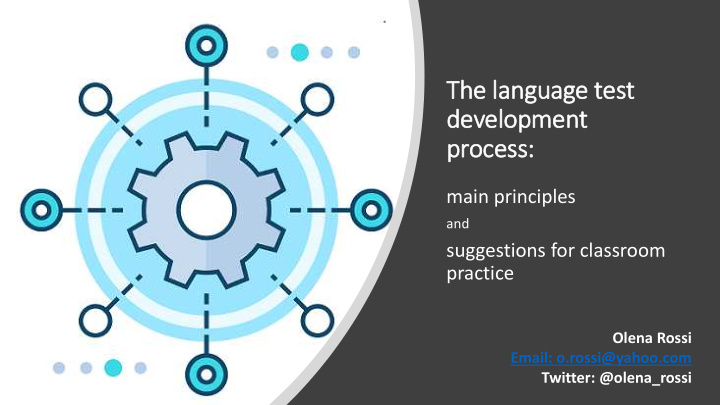



The la language test development process: main principles and suggestions for classroom practice Olena Rossi Email: o.rossi@yahoo.com Twitter: @olena_rossi
Item development Suggestions for and test validity classroom practice: • improving teachers' Test-writing The la Th language test t knowledge of language documentation development t assessment Item development proce cess: Main in • producing test for large testing prin inciples s and specifications suggesti su tions for organisations • writing test items in cla classroom practi tice teams • peer‐reviewing items • analysing student responses
Test validity “…a test is said to be valid if it measures Validity evidence: accurately what it is intended to measure” • statistical relationships of test scores with other (Hughes, 2003, p.26) information • experts' judgments of the extent to which the content of the test matches a curriculum or the requirements of a job • the qualifications of the test designers, question writers and reviewers • the process used to develop the test (ETS testing terms glossary)
Construct underrepresentation - the test fails to include important dimensions of A2 item : Wh-questions in the past the construct Stem ____ did you do on holiday last month? Option 1 * What Option 2 Where Option 3 Why
Construct-irrelevant variance - test scores are affected A2 item : Wh-questions in the past with factors unrelated to the skill or ability being Stem What ___you expect to achieve by measured disturbing my sleep at dawn? Option 1 *did Option 2 are Option 3 were
Construct-irrelevant variance in tests of writing ability General English, B1 level, YL (13-16 y. o.) ‘Write the conversation you have with a friend about the holiday you plan to have together.’ General English, B2 level, adults ‘Envy is the sin which most harms the sinner.’ Discuss. (from Hughes, 2003)
Large-scale test development: Test-writing documentation Test development process
Test-writing documentation Test framework construct format Test specifications expected responses sample items Item writer guidelines
Commissioning Pre-editing Editing Pretesting Standard fixing Test construction https://www.ielts.org/about-the-test/ Test data analysis how-we-develop-the-test
Item writing Item review • Content review • Fairness review • Editorial review Item trialling • Pretesting of reading/listening tasks • Tryouts of speaking/writing tasks Assembly of new test forms https://www.ets.org/s/toefl/pdf/ Post-administration review toefl_ibt_research_insight.pdf
Test development process 1 2 3 4 5 6 Deciding on the Writing test Producing test Moderating Trialling test Analysing test test purpose specifications items test items items results after and construct administration
Test development: Sugg ggestions for cla lassroom practice
teachers’ language assessment literacy test specifications test development process post-test analysis
Teachers’ language assessment literacy test use • Why to test? test construct • What to test? task/item types • How to test?
Teachers’ language assessment literacy test use • Why to test? test construct • What to test? task/item types • How to test?
Teachers’ language assessment literacy test use • Why to test? test construct • What to test? task/item types • How to test?
Good test specifications ... • describe the text types used • are presented in a systematic way • describe the content/topics to be • describe the test purpose included and to be avoided • define the test level • describe the scoring methods and • describe the test construct assessment criteria • describe the item/task types used • provide sample tasks/items • describe how students with special • describe the number, sequence, needs are accommodated instructions for the tasks/items • explain whether reference tools can be used during the test (cited from Lancaster MA in Language Testing by Distance teaching materials)
Test development process for classroom assessment Set up a Produce test Peer-review Write items working group specifications the items Try out the Post-test Revise the items on analysis items students
Post-test analysis A2 item : Requests Stem Could you ____ me the sugar, please? • student feedback on items Option 1 * pass • review of student Option 2 take responses Option 3 kiss Option 4 have Essay prompt: What are the advantages and disadvantages of having a blind date?
teachers’ language assessment literacy test specifications test development process post-test analysis
References and useful reading Alderson, J. C., Clapham, C., & Wall, D. (1995). Item writing and moderation. In J. C. Alderson, C. Clapham, & D. Wall (Eds.), Language test construction and evaluation (pp. 40 – 72). Cambridge, England: Cambridge University Press. Grabowski, K. C., & Dakin, J. W. (2014). Test development literacy. In A. J. Kunnan (Ed.), The companion to language assessment (pp. 751 –68). Hoboken, NJ: Wiley‐Blackwell. Hughes, A. (2003). Testing for language teachers (2nd ed.). Cambridge, England: Cambridge University Press. Rossi, O., & Brunfaut, T. (2019). Test item writers. In J. I. Liontas (Ed.), The TESOL Encyclopaedia of English Language Teaching (pp.1-7). John Wiley & Sons. DOI: 10.1002/9781118784235. eelt0981
The la language test development process: main principles and suggestions for classroom practice Olena Rossi Email: o.rossi@yahoo.com Twitter: @olena_rossi This Photo by Unknown Author is licensed under CC BY
Recommend
More recommend